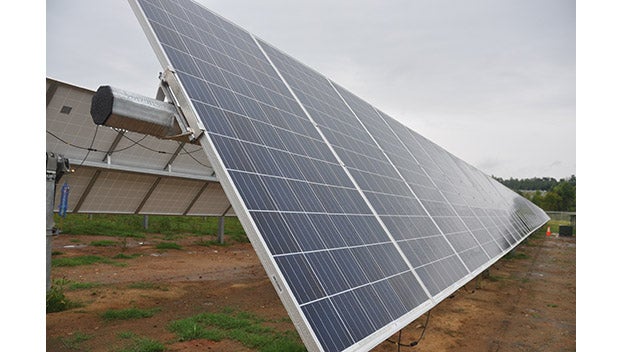Solar projects raise concerns about potential for fire
Published 6:55 am Friday, January 31, 2025
|
Getting your Trinity Audio player ready...
|
In virtually every solar hearing, both here in Charlotte and in neighboring counties, there’s one question asked. And in each one, the answer is either delayed, deferred or in some cases, the applicant simply says they don’t know. But when it comes to solar panels, knowing what to do if they catch on fire is critical.
If anyone is reading this for the first time, it would seem like common sense to just use water or foam. But when you’re dealing with electrical in general and specifically the components involved in a solar panel, firefighting takes a different approach.
Regardless of the source of the fire, the proximity of electrical components limits firefighting options, and can pose as an additional risk to emergency responders and other people nearby. Generally, normal water is a poor choice to use to put out an electrical fire.
Electrical components are commonly shielded in insulated materials to ensure that the only path electricity can flow is the intended one. In the presence of fire, such shieldings can warp and melt, exposing wire and other components underneath. Once exposed, the paths the electricity can take are much more uncertain.
The risks of arcing, shocking, and electrocution increase drastically in a wet environment. If the panel area was doused with water, or wet from past or current rain, it would be more dangerous to respond to the fire. Especially with the higher voltage equipment accompanying the actual panels, it is often not worth risking the lives of emergency responders. Instead, tactics would shift to containing the fire and supervising the natural burnout.
How do you stop a solar panel fire?
So how do you stop a solar fire? We’ll look at a couple options here. First off, we turn to neighboring Prince Edward County, where Gabriel Solar will go before supervisors this month, looking to get permitted on an 80 megawatt solar farm and 120 megawatt battery storage facility, covering a total of 539 acres.
At the January planning commission hearing in Prince Edward, Gabriel’s Director of Development, Michael Cook, said that the project would have a thermal management system, along with automated fire suppression systems, buffers to protect against flame escaping and a 24/7 Battery Protection Unit, which will monitor the structure. Cook also said the fire detection system provides early warning, before the solar panels even catch on fire.
If they get heated beyond what’s considered an acceptable degree, both the Gabriel officials and local firefighters will be notified. As for the battery storage, Cook said that the system will monitor voltage levels, temperature and state of charge, to prevent any overcharging, overdischarging or overheating.
The fire suppression system, meanwhile, will use gas to interrupt the chemical chain reaction that ignites fire on the panel. The system also will include ventilation dampers, to control gas exhaust during any such incident.
Some real-world experience
But since the majority of these projects, either in Prince Edward or surrounding counties, are still just in the planning stage, we needed to talk with people who have actually experienced the situation. What have they seen? What works and doesn’t work? To do that, we reached out to Melvin Evanicky, Assistant Chief with the Beasley Fire Department. That’s located near Houston, Texas. Beasley, and other small-town firefighters we spoke to who didn’t want to be named, each said fires are a rare occurrence. The highest number any had ever seen was three in a single year. However, none of those fires involved the actual equipment, in terms of what started it.
The majority of the fires seen seemed to have shared a common characteristic: poor lawn maintenance.“The only time we ever really see solar farm fires is when the grass is tall,” Evanicky said.
Electronics naturally heat up during usage, with higher voltage systems generating more heat. Not only are solar panels heating up during operations, but they are also, by design, sitting in direct sunlight. While these panels are designed to withstand high temperatures, the grass around them is a different story, Evanicky said.
The heat from the solar panels alone are not enough to ignite the surrounding grass, but other environmental factors can combine, leading to ignition. In general, the same factors that influence wildfire can apply here. In hotter, drier seasons, the flammability of grass increases. Depending on the type of grass, ventilation, temperature, and other contributing factors, a tuft of grass can smolder, and create an ember in the middle of, at that point, fairly decent tinder.
Putting the solar panels at risk
If the grass surrounding the solar panels is high and brushing up against hot components, this risk goes up. While the chances a single tuft of grass ignites is rather low, larger solar farms can take up acres worth of land. Even if you roll the dice at low odds, eventually with enough dice rolls, you’ll hit the target. The larger the acreage, the more grass, the more dice rolls.
In a well maintained solar farm, this chance is massively reduced. Keeping the grass cut, while not necessarily easy given the layout of the panels, goes a long way in preventing this type of fire. In Evanicky’s experience, there is a solar farm in his district that, up until this point, he has never visited due to there not being any fires. He has noted, while not specifically being the reason why, that field is always trimmed. Another field he does seem to visit, tends to have taller grass.
Dale Mensik wrote this for the Charlotte Gazette.






